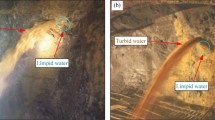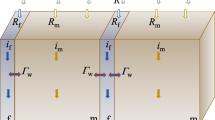Abstract
The CO2 migrated from deeper to shallower layers may change its phase state from supercritical state to gaseous state (called phase transition). This phase transition makes both viscosity and density of CO2 experience a sharp variation, which may induce the CO2 further penetration into shallow layers. This is a critical and dangerous situation for the security of CO2 geological storage. However, the assessment of caprock sealing efficiency with a fully coupled multi-physical model is still missing on this phase transition effect. This study extends our previous fully coupled multi-physical model to include this phase transition effect. The dramatic changes of CO2 viscosity and density are incorporated into the model. The impacts of temperature and pressure on caprock sealing efficiency (expressed by CO2 penetration depth) are then numerically investigated for a caprock layer at the depth of 800 m. The changes of CO2 physical properties with gas partial pressure and formation temperature in the phase transition zone are explored. It is observed that phase transition revises the linear relationship of CO2 penetration depth and time square root as well as penetration depth. The real physical properties of CO2 in the phase transition zone are critical to the safety of CO2 sequestration. Pressure and temperature have different impact mechanisms on the security of CO2 geological storage.

















Similar content being viewed by others
References
Bachu S, Bennion B (2008) Effects of in-situ conditions on relative permeability characteristics of CO2-brine systems. Environ Geol 54(8):1707–1722
Bandilla KW, Celia MA, Birkholzer JT, Cihan A, Leister EC (2015) Multiphase modeling of geologic carbon sequestration in saline aquifers. Ground Water 53(3):362–377
Carroll SA, Keating E, Mansoor K, Dai Z, Sun Y, Trainor-Guitton W, Brown C, Bacon D (2014) Key factors for determining groundwater impacts due to leakage from geologic carbon sequestration reservoirs. Int J Greenh Gas Control 29(29):153–168
Fan TB, Wang LS (2006) A viscosity model based on Peng–Robinson equation of state for light hydrocarbon liquids and gases. Fluid Phase Equilib 247(1):59–69
Gor G, Prevost J (2013) Coupled model for CO2 leaks from geological storage: geomechanics. Fluid flow and phase transitions. In: 13 AGU fall meeting abstracts
Heath JE, Dewers TA, Mcpherson BJOL, Nemer MB, Kotula PG (2012) Pore-lining phases and capillary breakthrough pressure of mudstone caprocks: sealing efficiency of geologic CO2 storage sites. Int J Greenh Gas Control 11:204–220
Heidaryan E, Moghadasi J, Rahimi M (2010) New correlations to predict natural gas viscosity and compressibility factor. J Pet Sci Eng 73(1–2):67–72
Hou Z, Rockhold ML, Murray CJ (2012) Evaluating the impact of caprock and reservoir properties on potential risk of CO2 leakage after injection. Environ Earth Sci 66(8):2403–2415
Jarrahian A, Heidaryan E (2014) A simple correlation to estimate natural gas viscosity. J Nat Gas Sci Eng 20(20):50–57
Keating EH, Newell DL, Viswanathan H, Carey JW, Zyvoloski G, Pawar R (2013) CO2/brine transport into shallow aquifers along fault zones. Environ Sci Technol 47(1):290–297
Kim S, Hosseini SA (2015) Hydro-thermo-mechanical analysis during injection of cold fluid into a geologic formation. Int J Rock Mech Min Sci 77(4):220–236
Lee SJ, Mcpherson BJ, Vasquez FG (2015) Leakage pathway estimation using iTOUGH2 in a multiphase flow system for geologic CO2 storage. Environ Earth Sci 74(6):1–18
Li Z, Dong M, Li S, Huang S (2006) CO2 sequestration in depleted oil and gas reservoirs-caprock characterization and storage capacity. Energy Convers Manag 47(11–12):1372–1382
Li Q, Liu G, Liu X, Li X (2013) Application of a health, safety, and environmental screening and ranking framework to the Shenhua CCS project. Int J Greenh Gas Control 17:504–514
Liu LC, Li Q, Zhang JT, Cao D (2016) Toward a framework of environmental risk management for CO2 geological storage in china: gaps and suggestions for future regulations. Mitig Adapt Strateg Glob Change 21(2):191–207
Matteo EN, Scherer GW (2012) Experimental study of the diffusion-controlled acid degradation of Class H Portland cement. Int J Greenh Gas Control 7(2):181–191
Mavko G, Nur A (1997) The effect of a percolation threshold in the Kozeny–Carman relation. Geophysics 62(5):1480–1482
Murata J, Ogihara Y, Koshikawa S, Itoh Y (2004) Study on watertightness of concrete. Mater J 101(2):107–116
Oostrom M, White MD, Porse SL, Krevor SCM, Mathias SA (2016) Comparison of relative permeability–saturation–capillary pressure models for simulation of reservoir CO2 injection. Int J Greenh Gas Control 45:70–85
Ouyang LB (2011) New correlations for predicting the density and viscosity of supercritical carbon dioxide under conditions expected in carbon capture and sequestration operations. Open Pet Eng J 4:13–21
Perrin JC, Benson S (2010) An experimental study on the influence of sub-core scale heterogeneities on CO2 distribution in reservoir rocks. Transp Porous Media 82(1):93–109
Pruess K (2011) Modeling CO2 leakage scenarios, including transitions between super- and sub-critical conditions, and phase change between liquid and gaseous CO2. Energy Procedia 4(3):3754–3761
Salimi H, Wolf KH, Bruining J (2012) The influence of capillary pressure on the phase equilibrium of the CO2–water system: application to carbon sequestration combined with geothermal energy. Int J Greenh Gas Control 11(11):47–66
Suzuki A, Fomin SA, Chugunov VA, Niibori Y, Hashida T (2016) Fractional diffusion modeling of heat transfer in porous and fractured media. Int J Heat Mass Transf 103:611–618
Tong F, Jing L, Zimmerman RW (2010) A fully coupled thermo-hydro-mechanical model for simulating multiphase flow, deformation and heat transfer in buffer material and rock masses. Int J Rock Mech Min Sci 47(2):205–217
Tonnet N, Mouronval G, Chiquet P, Broseta D (2011) Petrophysical assessment of a carbonate-rich caprock for CO2 geological storage purposes. Energy Procedia 4(4):5422–5429
Wang JG, Peng Y (2014) Numerical modeling for the combined effects of two-phase flow, deformation, gas diffusion and CO2 sorption on caprock sealing efficiency. J Geochem Explor 144:154–167
Wang JG, Kabir A, Liu J, Chen Z (2012) Effects of non-Darcy flow on the performance of coal seam gas wells. Int J Coal Geol 93(1):62–74
Wang JG, Liu J, Kabir A (2013) Combined effects of directional compaction, non-Darcy flow and anisotropic swelling on coal seam gas extraction. Int J Coal Geol 109–110(2):1–14
Wang JG, Ju Y, Gao F, Peng Y, Gao Y (2015) Effect of CO2 sorption-induced anisotropic swelling on caprock sealing efficiency. J Clean Prod 103:685–695
Wang JG, Ju Y, Gao F, Liu J (2016) A simple approach for the estimation of CO2 penetration depth into a caprock layer. J Rock Mech Geotech Eng 8(1):75–86
Wei X, Li Q, Li X, Niu Z (2016) Modeling the hydromechanical responses of sandwich structure faults during underground fluid injection. Environ Earth Sci 75(16):1155
Yang F, Bai B, Dunn-Norman S, Nygaard R, Eckert A (2014) Factors affecting CO2 storage capacity and efficiency with water withdrawal in shallow saline aquifers. Environ Earth Sci 71(1):267–275
Yoo JH, Lee HS, Ismail MA (2011) An analytical study on the water penetration and diffusion into concrete under water pressure. Constr Build Mater 25(1):99–108
Zhou Y, Rajapakse RKND, Graham J (1998) A coupled thermoporoelastic model with thermo-osmosis and thermal-filtration. Int J Solids Struct 35(34–35):4659–4683
Zhu WC, Wei CH, Liu J, Qu HY, Elsworth D (2011) A model of coal–gas interaction under variable temperatures. Int J Coal Geol 86(2–3):213–221
Acknowledgements
The authors are grateful to the financial support from the National Natural Science Foundation of China (Grant nos. 51674246, 51674250) and Creative Research and Development Group Program of Jiangsu Province (2014-27). The authors thank the editor and reviewers. Their constructive comments and suggestions help the authors significantly improve the quality of this paper.
Author information
Authors and Affiliations
Corresponding author
Appendices
Appendix 1: Gas exchange between fracture and matrix
The source term of gas adsorption from the matrix to the fracture is expressed as
where \(\frac{{{\text{d}}{m_{\text{b}}}}}{{{\text{d}}t}}\) represents the exchange rate of gas content between fractures and matrix, which is decided by the pressure balance. To describe this dynamic diffusion process, a diffusion time \(\tau\) is introduced to simply measure the gas exchange rate
where \({m_{\text{e}}}(p)\) is the equilibrium gas content with fracture pressure p. The diffusion time of a shale matrix block is generally expressed by
where D (m2/s) is the diffusion coefficient of gas and a (m−2) is a shape factor. For isotropic matrix, the shape factor is
where \(L_{x}^{{}}\) and \(L_{y}^{{}}\) are the fracture spacing in x-direction and y-direction, respectively. This diffusion in shale involves multi-scale flow mechanism (including adsorption, diffusion, slippage, and viscous flow) and makes the flow substantially deviate from Darcy flow.
Appendix 2: Capillary pressure model
The normalized saturation \(s_{{\text{w}}}^{*}\) of wetting phase is (see Brooks and Corey model)
where \({p_{\text{c}}}={p_{{\text{nw}}}} - {p_{\text{w}}}\) presents the difference between water pressure \({p_{\text{w}}}\) and gas pressure \({p_{{\text{nw}}}}\). The initial entry capillary pressure decides the occurrence of CO2 displacement of brine water. This pressure varies in a large range of 0.1–48.3 MPa (Tonnet et al. 2011). \(\lambda\) is the pore size distribution index. \({s_{{\text{rw}}}}\) and \({s_{{\text{rnw}}}}\) are the irreducible saturations of wetting and non-wetting phases, respectively. \({p_{\text{e}}}\) is the entry capillary pressure. Therefore, the compressibility with respect to capillary pressure is
Rights and permissions
About this article
Cite this article
Wang, J.G., Wang, H. Sealing efficiency analysis for shallow-layer caprocks in CO2 geological storage. Environ Earth Sci 77, 738 (2018). https://doi.org/10.1007/s12665-018-7924-2
Received:
Accepted:
Published:
DOI: https://doi.org/10.1007/s12665-018-7924-2




